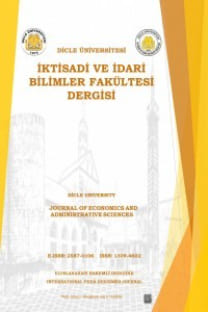ÜLKELERİN GELİŞMİŞLİK FARKLILIKLARI ÖZGÜRLÜK YAPISI İLE AÇIKLANABİLİR Mİ?
Ekonomik Özgürlük, Ekonomik Büyüme, Fiyat İstikrarı, Panel Veri Analizi
CAN THE DEVELOPMENT DIFFERENCES OF COUNTRIES BE EXPLAINED WITH A FREEDOM STRUCTURE?
Economic Freedom, Economic Growth, Price Stability, Panel Data Analysis,
___
- Banaian, K. & Luksetich, W. (2001). Central bank independence, economic freedom, and inflation rates. Economic Inquiry. 39(1), 149-161 (30.05.2022) https://doi.org/10.1111/j.1465-7295.2001.tb00057.x.
- Barro, R. J. (1991). Economic growth in a cross section of countries. Quarterly Journal of Economics, 106(2): 407-443. https://doi.org/10.2307/2937943
- Barro, R., J. (1996). Democracy and growth. Journal of economic growth, 1(1), 1-27.
- Barro, R. J. (2013). Democracy, law and order, and economic growth. In AT Miller, K., R. Holmes, and E., J. Feulner (Eds.), 2013 Index of Economic Freedom Chapter 3 (pp.41-58). The heritage foundation and Dow Jones and Company, Inc.
- Bengoa, M. & Sanchez-Robles, B. (2003). Foreign direct ınvestment, economic freedom and growth: new evidence from Latin America. European Journal of Political Economy, 19(3), 529-545.
- Brkic, I. Gradojevic, N. & Ingjattijević, S. (2020). The ımpact of economic freedom on economic growth? New European dynamic panel evidence. Journal of Risk Financial Management, 13 (2), 1-13.
- Carlsson, F. & Lundström, S. (2002). Economic freedom and growth: decomposing the effects. Public Choice, 112 (3-4), 335-344.
- Crampton, E., (2002). You get what you vote for: electoral determinants of economic freedom, Journal of Private Enterprise, 18(0211003), 1-20.
- Dawson, J., W. (2003). Causality in the freedom–growth relationship. European Journal of Political Economy, 19 (3), 479-495.
- De Haan, J. & Sturm, J. E. (2000). On the relationship between economic freedom and economic growth. European Journal of Political Economy, 16 (2), 215-241.
- Doucouliagos, C. & Ulubasoğlu, M., (2004). Economic freedom and economic growth: selection, specification and genuine effects. In European Public Choice Society Meetings.
- Eser, Z. E. (2016). Economic freedoms and development [Unpublished PhD Thesis]. Karadeniz Technical University Institute of Social Sciences.
- Friedman, M. (2018). Capitalism and freedom (5th ed.). (D. Erberk and N. Himmetoğlu, Trans.). Eksi Books.
- Grubel, H. G. (1998). Economic freedom and human welfare: Some empirical findings. Cato Journal, 18(2), 287-304.
- Güriş, S. (2015). Stata ile panel veri modelleri. Der Yayınları.
- Gwartney, J. D, Holcombe, R., G. & Lawson R., A. (2004). Economic freedom, ınstitutional quality, and cross-country differences in income and Growth. Cato Journal, 24(3), 205-233.
- Gwartney, J. D. Holcombe, R. G. & Lawson, R. A. (2006). Institutions and the Impact of investment on growth. Kyklos, 59(2), 255-273.
- Gwartney, J., D., Lawson, R., A. & Helcombe, R. G. (1999). Economic freedom and the environment for economic growth. Journal of Institutional and Theoretical Economics, 155(4), 643- 663.
- Gwartney, J. D. Lawson, R. A. & Block, W. (1996). Economic freedom in the world: 1975-1995. Fraser Institute
- Heckelman J. C. (2000). Economic freedom and economic growth: a short-run causal investigation. Journal of Applied Economics, 3(1), 71-91.
- Herrera-Echeverri, H., Haar, J. and Benavides Estévez-Bretón, J. (2013). Foreign direct ınvestment, ınstitutional quality, economic freedom and entrepreneurship in emerging markets. Journal of Business Research, 67(9), 1921-1932.
- Knack S. and Keefer, P. (1995). Institutions and economic performance: cross-country tests using alternative ınstitutional measures. Economics and Politics, 7(3), 207-227.
- Koçak, E. (2016). Democracy, economic freedoms and growth: theory and empirical application [Unpublished Doctoral Dissertation]. Erciyes University Institute of Social Sciences.
- Mahmood, K. Taseef A. Imran S. & Faridi, M. Z. (2010). Impact of economic freedom on economic growth: the case of some selected search member countries. International Research Journal of Finance and Economics, 52, 7-16.
- Nelson, M. A. & Singh, R. D. (1998). Democracy, economic freedom, fiscal policy and growth ın lDCS: a fresh look. Economic Development and Cultural Change, 46(4), 677-696.
- Tatoğlu, Yerdelen, F. (2020). Panel data econometrics (5th Edition). Beta Publishing.
- Torstensson, J. (1994). Property rights and economic growth: an empirical Study. Cyclos, 47 (2), 231-247.
- Tunçsiper, B. & Biçen, Ö. F. (2014). Examination of the relationship between economic freedoms and economic growth by panel regression method. Eskişehir Osmangazi University Journal of Feas, 9(2), 25-45.
- Williamson, C. R. & Mathers, R. L. (2011). Economic freedom, culture and growth. Public Choice, 148(3-4), 313-335.
- Yalman, İ., N. Sandalcılar, A. R. & Demirkoparan, F. (2011). Freedoms and economic development: Latin America and Turkey. Ataturk University Journal of FEAS. 10. Special Issue of Econometrics and Statistics Symposium, 431-444.
- ISSN: 1309-4602
- Yayın Aralığı: Yılda 2 Sayı
- Başlangıç: 2011
- Yayıncı: Dicle Üniversitesi
EKONOMİK KRİZ VE HALK EKMEK KUYRUKLARI: MERSİN ÖRNEĞİ
Erkan AKTAŞ, İhsan KAMALAK, İlkay YILMAZ
TÜRKİYE'DE COVID-19’UN MEKÂNSAL FARKLILIKLARI
BAŞLICA ENERJİ KAYNAKLARI VE ÇEVRESEL ETKİLERİNİN DEĞERLENDİRİLMESİ
SİMÜLASYON TEMELLİ TIP EĞİTİMİN BÜTÇEYE SAĞLADIĞI KLİNİK VE EKONOMİK FAYDALAR
GELİR GRUPLARINA GÖRE COVID-19 PANDEMİSİNDE SAĞLIK SİSTEM PERFORMANSI ETKİNLİĞİNİN ÖLÇÜLMESİ
BIST SİGORTA ŞİRKETLERİNİN CRITIC TEMELLİ PROMETHEE II YÖNTEMİ İLE PERFORMANS ANALİZİ
TÜRKİYE’DE KATILIM BANKALARI VE KONVANSİYONEL BANKALAR ARASINDAKİ REKABET ÜZERİNE NİCEL ARAŞTRMA
Ali Rıza SOLMAZ, Özgür Bayram SOYLU
TÜRKİYE’DE STANDART OLUŞTURULMASI SÜRECİNE İLİŞKİN BİR DEĞERLENDİRME: KÜMİ FRS ÖRNEĞİ
Nurettin ÖZDEMİR, Elçin DALKILIÇ
TR DİZİN-İŞLETME DERGİLERİNİN ÇOK KRİTERLİ BİR KARAR VERME PERSPEKTİFİNDEN DEĞERLENDİRİLMESİ
